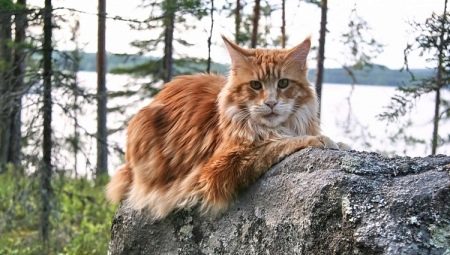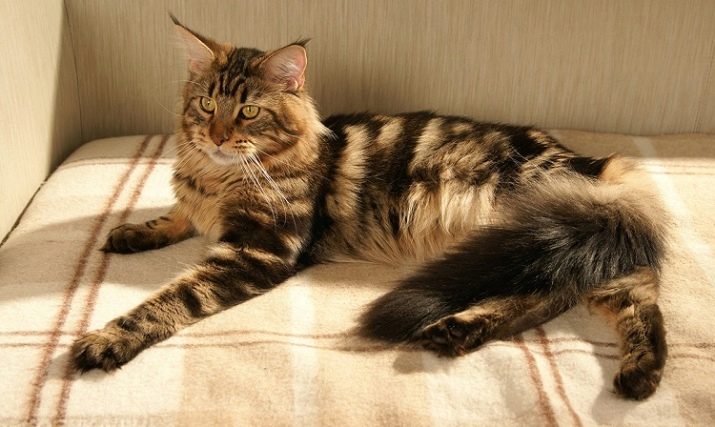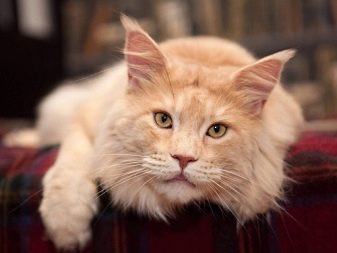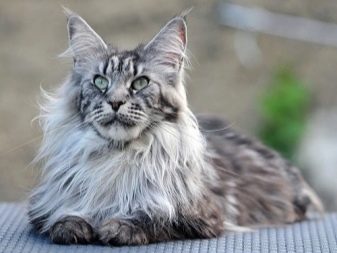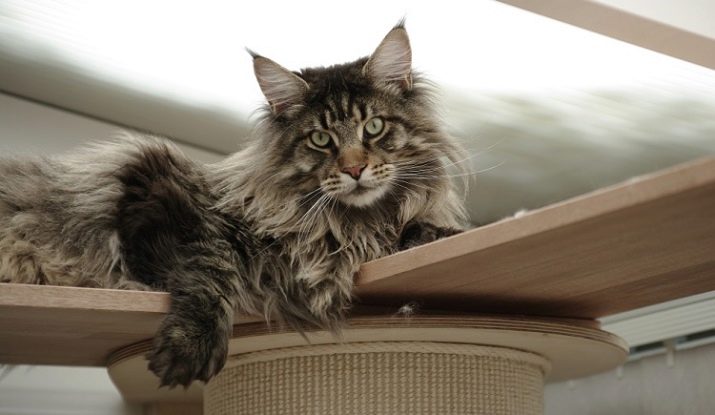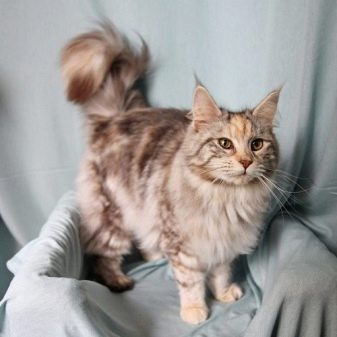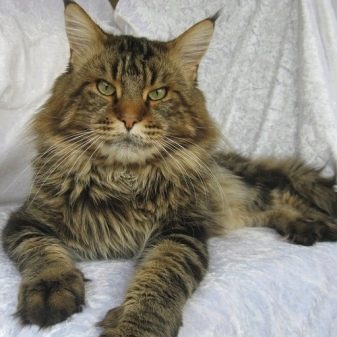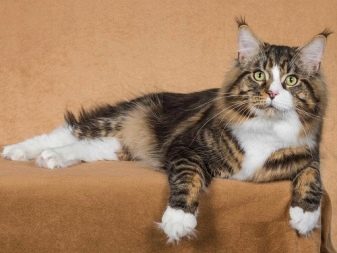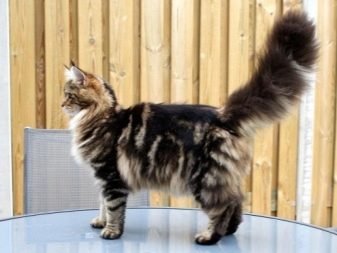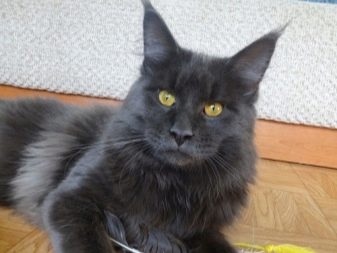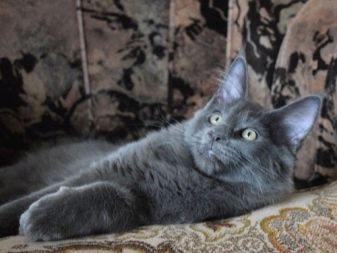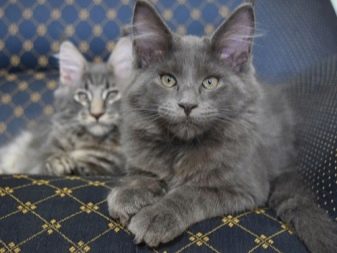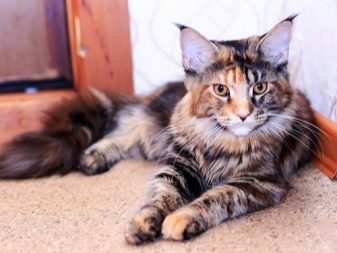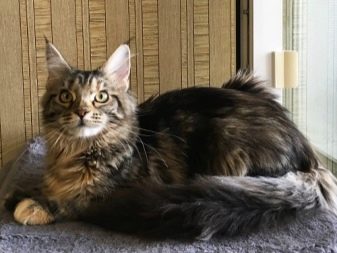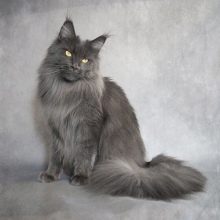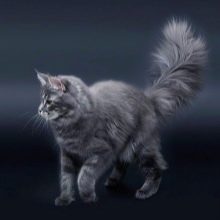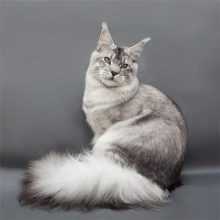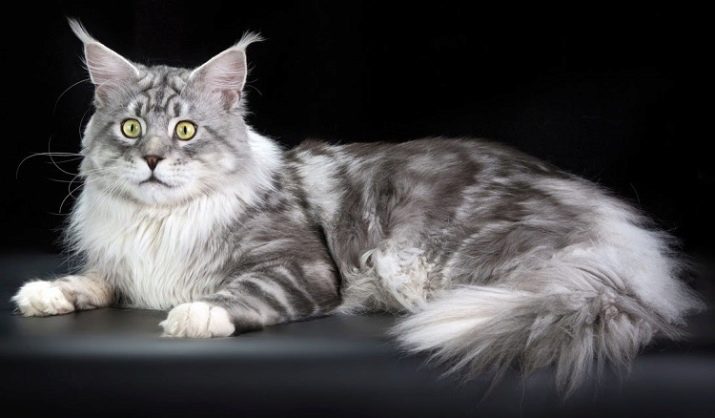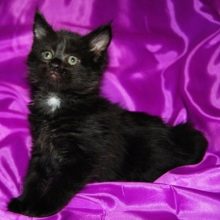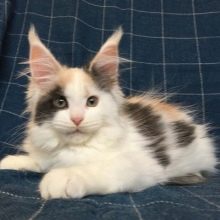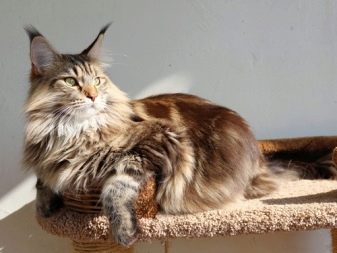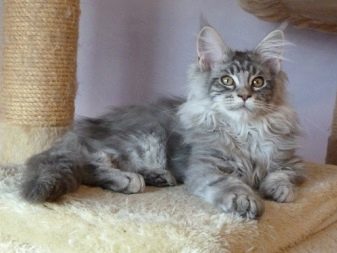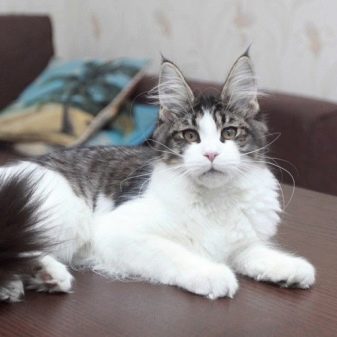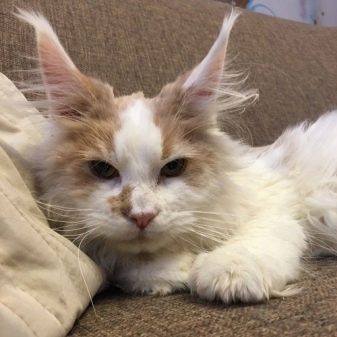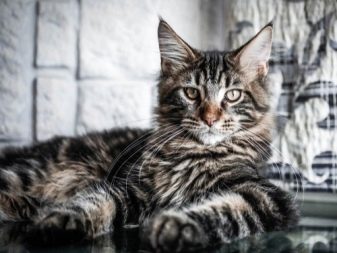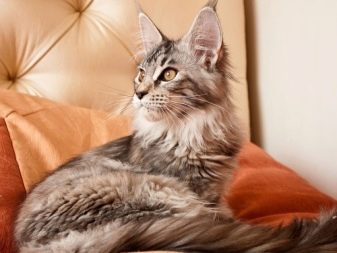Cats of the Maine Coon breed are very popular all over the world. The reason is obvious - unusual large sizes, elegant “tassels” on the ears and a variety of original colors. A professional just need to look at the shade and pattern of animal hair, eye color, to tell a lot about it.
Principles of classification
Maine-coons have several varieties of color, however, all this diversity is reduced to only 2 genetic colors - black and red. The remaining colors are bred by the breeders and are based on these two natural colors. At the same time, modern science believes that the Maine Coons are bred in a natural way. Living on farms, feeding on large rodents and breeding within a limited population, these animals acquired large sizes and characteristic traits of the breed.
The need to mimic the surrounding nature determined the peculiarities of coloring. Today, felinology calls Taaska color "black marble." That is exactly this color - natural. With the time of the spread and demand of the breed around the world, new colors have appeared. For the convenience of breeders adopted a single international classification of colors. It is based on 3 components:
- coat color;
- the presence of pattern on the wool - usually these are strips, which sometimes can turn into curls;
- the presence of spots, their size and shades.
Description of color types
Let us consider in more detail what types of Maine Coon colors are.
Tabby
Color tabby is present in all Maine Coons (but not all of it is pronounced). This is explained by the fact that a similar color is laid genetically - the hair of an animal is zoned, that is, striped. In some literature, you can find the name "Tabby" - in English style.
In addition, this particular shade originally had any forest or wild cat.
The color “tabby” can have several variations - depending on how dark and light areas of hairs alternate and fold in the hair. For example, solid parallel stripes are a sign of tiger tabby. If the stripes are intermittent, the color is called "spotted." Under the "classic" means marble pattern (divorce).
A variation of this type of color can be considered "ticking". The latter implies ticking (that is, the presence of strips) throughout the body of the animal, however, the pattern is not pronounced. Sometimes only these bands appear on the forehead, chest, paws of the animal. Cats with a ticking pattern are often found among the Abyssinian, ticked Maine Coon - a rarity, therefore, so valued.
Among the individuals with the color "tabby" can be distinguished black cats. This is not a mistake - black under it always has residual strips (“tabby”). They are especially noticeable in kittens. It seems that the thinnest black veil is draped over the fur with a pattern. As the individual grows older, the pattern appears less and less, the wool becomes a noble black color. However, the latter is largely the merit of the owner of the Maine Coon.
To save a black fur coat, an animal requires special care and diet, it is contraindicated for him to stay in the sun (this can cause brown spots on the black wool).
Solid
Cats with this color do not have a pattern (or are characterized by a “shadow”, that is, a not very pronounced pattern). For solid is inherent in the full color of the hair of the animal along the entire length. However, sometimes an individual has a lighter shade undercoat. Other spots are marriage. Solid can be red, black, white, cream and blue.
Among them, the red (i.e. red) solid is especially rare and expensive.
It is interesting that Red shade itself is one of the most common in Maine Coons. However, the pattern on the wool appears brighter. In other words, in the specialized market, one can most often see red variations of “tabby”, spotted red Maine coons, while these same red cats, but already “solid”, are a real rarity.
Widespread in the West have received blue solidi. In our country they are sometimes mistakenly called gray, however, the difference between blue, smoky and silver cats is colossal. Connoisseurs' delight is caused by the color “blue smoke”, in which Maine does not have a pronounced pattern, however, its hair includes several variations of colors - from silver to graphite.
It should be said separately about the white solid. In any case, the white color of Maine wool is not a color, but a lack of pigment. Snow-white kittens may sometimes have darker specks on the face, disappearing as the animal grows. White Maine Coons are unpretentious in care, however, they may be deaf. That is why it is better to get them from famous and experienced breeders.
It is unacceptable to cross two white individuals, since this invariably leads to genetic abnormalities.
Because of the fear of the deafness of the animal, many people choose not white, but cream cats. This color is the result of the clarification of the classic red. The result is a cream-ginger animal. However, to reach a pure solid is problematic, strips or a classic pattern manifest themselves (usually on the muzzle, breast, legs).
Tortoiseshell
Maine-coons with a tortoise-colored tricolor Maine Coon, which has a picturesque appearance. Based on the shade that prevails, tortoise-colored maine coons are subdivided into:
- "Torbi" (color consists of black and red);
- "Tortie" (they are joined by a clarified cream shade).
Additionally, haze or silver may be present. Interestingly, tortoises are usually born female. The chance of being born to a male individual is 1: 1000. The tortoiseshell color can be complemented with white spots that have clearly defined outlines. Such color is called “calico” (in translation - flap, chintz).
Silver and smoky
Smoky Maine Coons are very popular and look very impressive. With this color, each cat's hair has a white base and a tip with a pigment. And the color can have different intensity from darker smoky to very light silver. For example, black smoke cats have a strongly pronounced shade of fur. The intensity of the color depends on what part of the individual's hair is dyed:
- if half the hair is dyed, then this is “regular smoke”;
- at coloring 1/4 of hair it is considered that this is “shaded smoke”;
- hair dyed 1/8 part, in front of us Maine Coon color "Chinchilla".
Separately, this group distinguishes Maines with an exquisite silver color. It can be so light and light that it is easy to confuse such individuals with whites, especially in childhood. Traditionally, kittens are distinguished by the color of the iris. Snow-white animals have blue eyes, while silver ones are green-eyed beauties.
As the individual grows, the wool darkens somewhat, and the “tobby” pattern becomes more pronounced on it. Great value are considered to be Maine Coons color "marble on silver". They have a light silver color with a darker spiral pattern, as if imitating the color of marble. This group includes peach Maine Coon. These cats have white hairs, and bright red on the tips. Thanks to this combination, a soft peach coat color is obtained.
With white spots
First of all, it should be said that spotted Maine Coons are not bicolor.Bicolor, according to the international standard, is when the ratio of white and colored wool on the body of an animal is 1: 1. Maine Coons can have the following types of white spots:
- "Buttons" - are small located chaotically white spots throughout the body of the animal;
- "medallion" - the spot is noticeable, located on the cat's breast;
- "Gloves" - Speech on the white legs of the animal;
- "Van" - almost white Maine with colored spots on the head and tail;
- "harlequin" - on white fur large colored spots.
There is also a color "tuxedo". It is not included in the international classification, but is often used by pet owners. It implies white legs and breast of the animal against the background of the rest of the colored fur, while white and colored fur are usually contrasted.
Random color combination
There are a lot of Maine Coons colors, among them - a random combination. Consider the options adopted by the breeders:
- brown spotted tabby - Maine Coon in brown and reddish spots;
- "Diluted turtle" - blue-cream shade, which is a combination of blue spots and cream (ginger) color;
- blue spotted tabby - Maine-kun blue color with cream spots.
Seals of the specified group have no white spots. There are also individuals with a random combination of colors - white spots:
- blue and cream with white spots - the cat has a blue and cream color and white spots;
- spotted tabby with white - animal tabby color with white spots.
Color coding
Understand what color Maine Coon, allows a single international system of EMS, according to which each color is assigned an individual code. Consider this in the form of a table. In such a system, the Maine Coon is supposed to have the following types of color:
N | the black |
A | blue (the result of oxidation black tint) |
E | cream (ginger) |
D | red |
F | turtle (mostly females) |
G | blue-cream (result of tortoise color oxidation) |
S | smoky, silver |
W | white |
If there are white spots on the skin, a numeric code is added to the specified letter code:
- if the animal is white with one or several spots of the main color, then it “receives” the “van” classification - 01;
- if 2/3 of the individuals are white, then this is a “harlequin” - 02;
- a two-color pet or bicolor is 03;
- with white (if it is less than half) - 04.
The presence and type of pattern of the coat allows you to select the following types of raccoon cats:
- classic tabby or marble (the animal has a pattern in the form of the letter "M" on the forehead or "butterfly" on the sides) - code 22;
- mackerel or tiger tabby (it can be recognized by the already mentioned letter "M" on the forehead, in addition, the animal has stripes like tiger skin color all over its body) - 23;
- spotted (the so-called torn tiger or spotted) - 24;
- shaded (a manifestation of color tabby on silver wool because of what it looks blurry) -11;
- chinchilla - black series of colors, cameo - red series -12;
- agouti factor (by color it is obvious that the individual is tabby, but the drawing is difficult to attribute to a specific type) - 21.
Sometimes, when describing an individual, an eye color characteristic can be used. When it is taken into account, special codes are also used:
- blue-eyed Maine Coons are encoded as 61;
- cats with yellow, orange or golden eyes have code 62;
- at disagreements indicate the code 63;
- green-eyed have code 64.
Thus, the classification uses the specified colors. But the chocolate color, gold, cinnamon are considered unacceptable.
You can learn about the features of Maine Coon care by watching the video below.
